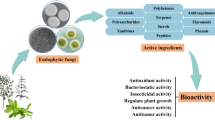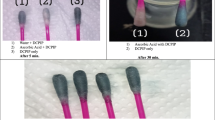Abstract
Taxol is produced by a few microorganisms and plants such as yew (Taxus sp.). Recent researches have shown that hazel (Corylus avellana L.) is also able to produce Taxol. In the present study, effects of different concentrations of phenylalanine (Phe) on the production of Taxol, antioxidant activity, and cytotoxic effects of extracts of suspension-cultured hazel cells were investigated. The cells were treated with different concentrations of Phe on day 7 of subculture and were harvested on day 14. The results showed that the amounts of Taxol and antioxidant activity were increased by increasing the phenylalanine supply. Interestingly, the cytotoxic effects of hazel cell extract were even stronger than that of pure Taxol (standard), suggesting hazel cell extract as a novel and suitable probe for treating human cancer. Application of phenylalanine to hazel cells exaggerates their effects.





Similar content being viewed by others
References
Wani MC, Taylor HL, Wall ME, Coggon P, McPhail AT (1971) Plant antitumor agents. VI. The isolation and structure of Taxol, a novel antileukemic and antitumor agent from Taxus brevifolia. J Am Chem Soc 93:2325–2327
Kohler J, Goldspiel BR (1994) Evaluation of new drug Paclitaxel (Taxol). Pharmacotherapy 14:3–34
Navia-Osorio A, Garden H, Cusido RM, Palazon J, Alfermann AW, Pinol MT (2002) Taxol and baccatin III production in suspension cultures of Taxus. J Plant Physiol 159:97–102
Fett-neto AG, Melanson S, Sakata F, DiCosmo J (1993) Improved growth and Taxol yield in developing calli of Taxus cuspidata by medium composition modification. Biotechnology 11:1007–1012
Tabata H (2004) Paclitaxel production by plant cell culture technology. Adv Biochem Eng Biotechnol 87:1–23
Rezaei A, Ghanati F, Behmanesh M, Mokhtari-Dizaji M (2011) Ultrasound potentiated salicylic acid-induced physiological effects and production of Taxol in hazelnut (Corylus avellana L.) cell culture. Ultrasound Med Biol 37:1938–1947
Zhao J, Davis LC, Verpoorte R (2005) Elicitor signal transduction leading to production of plant secondary metabolites. Biotechnol Adv 23:283–333
Wu J, Ge X (2004) Oxidative burst, jasmonic acid biosynthesis, and Taxol production induced by low-energy ultrasound in Taxus chinensis cell suspension cultures. Biotechnol Bioengeen 85: 714–721
Yu LJ, Lan WZ, QinWM XuH-B (2002) High stable production of taxol in elicited synchronous cultures of Taxus chinensis cells. Process Biochem 38:207–210
Zhi M, Yuan YJ, Ren D (2004) Acting point in taxol biosynthesis pathway of elicitor in suspension cultures of Taxus chinensis var. mairei. Acta Bot Sin 46:730–737
Zhang CH, Fevereiro PS, He G, Chen Z (2007) Enhanced paclitaxel productivity and release capacity of Taxus chinensis cell suspension cultures adapted to chitosan. Plant Sci 172:158–163
Ouyang J, Wang XD, Zhao B, Wang YC (2005) Enhanced production of phenylethanoid glycosides by precursor feeding to cell culture of Cistanche deserticola. Process Biochem 40:3480–3484
Fett-neto AG, Melasan SJ, Nicholson SA (1994) Improved Taxol yield by aromatic carboxylic acid and amino acid feeding to cell culture of Taxus cuspidata. Biotechnol Bioeng 44:967–971
Hoffman A, Khan W, Worapong J, Strobel G, Griffin D, Arbogast B, Barofsky D, Boone RB, Ning L, Zheng P, Daley P (1998) Bioprospecting for Taxol in angiosperm plant extracts. Spectroscopy 13:22–32
Bestoso F, Ottaggio L, Balbi A, Damonte G, Degan P, Mazzei M, Cavalli F, Ledda B, Miele M (2006) In vitro cell cultures obtained from different explants of Corylus avellana produce Taxol and taxanes. BMC Biotechnol 6:45–48
Otaggio L, Bestoso F, Armirotti A, Balbi A, Damonte G, Mazzei M, Sancandi M, Miele M (2008) Taxanes from shells and leaves of Corylus avellana. J Nat Prod 7:58–60
Jennewein S, Croteau R (2001) Taxol: biosynthesis, molecular genetics, and biotechnological applications. Appl Microbiol Biotechnol 57:13–19
Furmanowa M, Oledzka H, Syklowska-Baranek K, Jozefowicz J, Gieracka S (2000) Increased taxane accumulation in callus cultures of Taxus cuspidata and Taxus × media by some elicitors and precursors. Biotechnol Lett 22:1449–1452
Rafat A, Koshy P, Sekaran M (2010) Antioxidant potential and content of phenolic compounds in ethanolic extracts of selected parts of Andrographis Paniculata. J Med Plants Res 4:197–202
Gao H, Shupe TF, Hse CY, Eberhardt TL (2006) Antioxidant activity of extracts from the bark of Chamaecyparis lawsoniana (A. Murray) Parl. Holzforschung 60:459–462
Gamborg OL, Miller RA, Ojima K (1968) Nutrient requirements of suspension cultures of soybean root cells. Exp Cell Res 50:151–158
Veeresham C, Mamatha R (2003) Production of taxol and its analogues from cell cultures of Taxus wallichiana. Pharm Biol 4:426–430
Wu J, Lin L (2003) Enhancement of taxol production and release in Taxus chinensis cell cultures by ultrasound, methyl jasmonate and in situ solvent extraction. Appl Microbiol Biotechnol 62:151–155
Chua MT, Tung YT, Chang ST (2007) Antioxidant activities of ethanolic extracts from the twigs of Cinnamum osmophloeum. Bioresource Technol 99:1918–1925
Maikai VA, Kobo PI, Maikai BVO (2010) Antioxidant properties of Ximenia americana. Afr J Biotechnol 9:7744–7746
Oyaizu M (1986) Studies on product browning reaction prepared from glucosamine. J Nutr 44:307–315
Cai XX, Luo E, Yuan Q (2010) Interaction between Schwann cells and osteoblasts in vitro. Int J Oral Sci 2:74–81
Edhahiro JI, Nakamura M, Seki M, Furusaki S (2005) Enhanced accumulation of anthocyanin in cultured strawberry cells by repetitive feeding of l-phenylalanine into the medium. J Biosci Bioeng 99:43–47
Luo J, He GY (2004) Optimization of elicitors and precursors for paclitaxel production in cell suspension culture of Taxus chinensis in the presence of nutrient feeding. Process Biochem 39:1073–1079
Kubota N, Yakushiji H, Nishiyama N, Mimura H, Shimamura K (2001) Phenolic contents and l-phenylalanine ammonia-lyase activity in peach fruit as affected by rootstocks. J Japan Soc Hort Sci 70:151–156
Demirci B, Kosar M, Demirci F (2007) Antioxidant activities of the essential oil of Chaerophyllum libanoticum Boiss. et Kotschy. Food Chem 105:1512–1517
Kalpna R, Mital K, Sumitra C (2010) Vegetable and fruit peels as a novel source of antioxidants. J Med Plants Res 5:63–71
Chang ST, Wu JH, Wang SY, Kang PL, Yang NS, Shyur LF (2001) Antioxidant activity of extracts from Acacia confusa bark and heartwood. J Agric Food Chem 49:3420–3424
Kosinska A, Karamac M (2006) Antioxidant capacity of roasted health-promoting products. Pol J Food Nutr Sci 15:193–198
Colangelo D, Guo H, Konnors K, Kubota T, Silvestro S, Hoffman R (1992) Correlation of drug response in human tumors histocultured in vitro with an image-analysis MTT end point and in vivo xeno-grafted in nude mice. Anticancer Res 12: 1373–1376
Author information
Authors and Affiliations
Corresponding author
Rights and permissions
About this article
Cite this article
Bemani, E., Ghanati, F., Rezaei, A. et al. Effect of phenylalanine on Taxol production and antioxidant activity of extracts of suspension-cultured hazel (Corylus avellana L.) cells. J Nat Med 67, 446–451 (2013). https://doi.org/10.1007/s11418-012-0696-1
Received:
Accepted:
Published:
Issue Date:
DOI: https://doi.org/10.1007/s11418-012-0696-1




